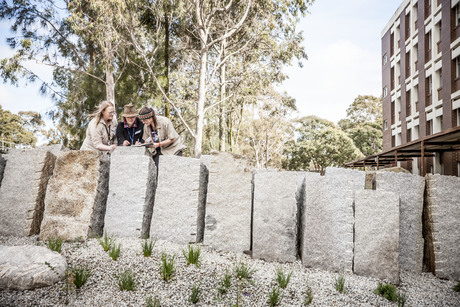A 'living' geological map at Monash University

The Monash Earth Sciences Garden, said to be the first of its kind in Australia, is anticipated to establish a hands-on approach to teaching geology, physical geography and atmospheric sciences. The 120 x 30 m garden was officially opened last week by the director of the Geological Survey of Victoria, Paul McDonald.
Inspired by the geology and physical geography of Victoria, the garden is a ‘living’ geological map comprising nearly 500 rock specimens. They have been laid out to represent a pattern of rock outcrops and set amongst beautiful native plants representing each geographical region. Aimed primarily at undergraduate students as well as secondary and high school students, the garden also provides a relaxation space for students and visitors.
Landscape Architectural practice Rush\Wright Associates designed the garden in consultation with staff of the School of Earth, Atmosphere and Environment at Monash, as well as artists Open Spatial Workshop. Construction was carried out by Australian Native Landscape Constructions (ANLC), who were responsible for procuring and delivering to site over 700 tonnes of rock formations.

The rock specimens represent a variety of igneous, sedimentary and metamorphic rocks found in Victoria. Highlights include:
- 125-million-year-old Cretaceous sandstone from the Otway Ranges, where significant dinosaur fossils have been found and continue to be studied at Monash University;
- large black volcanic ‘bombs’ — approximately 1 m in diameter — from an 8000-year-old volcano near Colac. This volcano is located in the Newer Volcanics Province (NVP);
- basalt columns similar to those located within the Organ Pipes National Park. These represent lava flows from the NVP volcanoes, which filled in valleys and created western Victoria’s flat landscape;
- 400 million-year-old limestone from Buchan in eastern Victoria, comprising fossils of marine creatures that were building reef systems in tropical seas when Victoria straddled the equator;
- folded rocks and quartz veins representing the geology of the Victorian Goldfields;
- a seasonally dry, mud billabong that reflects the semi-dry south-eastern Australian climate.

Monash’s Head of School, Earth, Atmosphere and Environment, Professor Sandy Cruden, was part of the team of earth scientists who developed the Earth Sciences Garden concept. He explained, “The earth sciences textbook is brought to life by this dynamic outdoor classroom, which offers a practical approach to learning field measurement and mapping techniques, and rock and mineral recognition skills. It reflects the Faculty of Science’s wider approach to teaching science in more innovative and engaging ways.”
“More than ever, we need graduates in geological sciences who are ‘field ready’ and capable of stepping straight into the diverse range of careers this dynamic area of science offers,” added McDonald. “The Monash Earth Sciences Garden provides this crucial hands-on exposure to the Earth’s rich geological formations and will inspire future generations of earth scientists.”
Liquid catalyst could transform chemical manufacturing
A major breakthrough in liquid catalysis is transforming how essential products are made, making...
How light helps plants survive in harsh environments
Researchers from National Taiwan University have uncovered how light stabilises a key...
SKA-Low's first image of the universe released
The image is an indication of the scientific revelations that will be possible with the...




